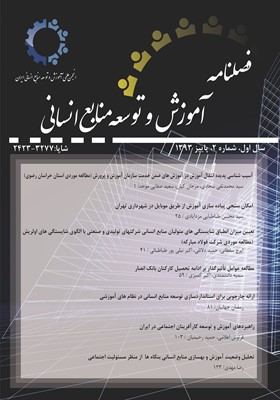ارائه چارچوبی برای استانداردسازی توسعه منابع انسانی در نظامهای آموزشی
محورهای موضوعی :
1 -
کلید واژه: چارچوب استانداردسازی توسعه منابع انسانی نظامهای آموزشی,
چکیده مقاله :
هدف پژوهش حاضر ارائه چارچوب استانداردسازی توسعه منابع انسانی در نظامهای آموزشی است که به روش توصیفی از نوع پیمایشی اجرا گردید. جامعه آماری کلیه اساتید و مدرسین رشتهها و گرایشهای علوم تربیتی واحدهای دانشگاه آزاد اسلامی منطقه 12 کشوری به تعداد 255 نفراست و نمونه آماری نیز مساوی جامعه آماری، که با استفاده از روش سرشماری انتخاب گردید. ابزار جمعآوری دادهها پرسشنامه محقق ساخته میباشد. نتایج به دست آمده نشان دادکه ، چارچوب استانداردسازی توسعه منابع انسانی دارای چهار بعد و بیست و سه مؤلفه به شرح زیر میباشد. بعد تعهد، شامل: تعهد علنی جهت توسعه افراد در تمامی سطوح، آگاهی کليه کارکنان از چشمانداز و اهداف کلان، تدوين طرح جامع کسب و کار، تدوين نيازهای آموزشی و توسعه کارکنان، آگاهی کليه کارکنان از نقش خود در موفقيت سازمان، ارتباط مديريت ارشد با نمايندگان کارکنان و ارتباط مديريت ارشد با نمايندگان کارکنان میباشد. بعد طرحریزی، شامل: تدوين منابع لازم آموزش و توسعه، ارزيابی نيازهای آموزش و توسعه با توجه به اهداف، طراحی فرايند ارزيابی نيازهای آموزش و توسعه، تعيين مسئوليت توسعه افراد در سراسر سازمان، صلاحيت مديران جهت توسعه کارکنان، تناسب اهداف و استانداردهای توسعهای و پيوند اهداف آموزشی به استانداردهای خارجی است. بعد اقدام، شامل: معارفه کارکنان جديد و تعيين نيازهای آموزش و توسعه آنها، توسعه مهارتهای کارکنان متناسب با اهداف، آگاهی کارکنان از فرصتهای توسعه، تشويق کارکنان در تعيين نيازهای آموزشی و نحوه تأمين آنها، اقدامات مؤثر جهت تحقق اهداف آموزش و توسعه و اقدامات مؤثر جهت تحقق اهداف آموزش و توسعه میباشد. بعد ارزیابی، شامل: ارزيابی نقش توسعه کارکنان در اهداف، ارزيابی نتايج آموزش و توسعه در سطوح فردی، گروهی و سازمانی و آگاهی مديريت ارشد از هزينهها و منافع توسعه افراد است.
The purpose of the current study is to provide a framework for standardizing human resource development in educational systems. The descriptive survey method was conducted. The population consists of all professors and teachers in the field of educational sciences in Islamic Azad University in region 12 of Iran who were 255 persons. The sample is also equal to population that were selected using census sampling and also the census methods used. Data was collected via a researcher made questionnaire. The results show that, the framework for standardizing human resource development have four dimensions and twenty-three components, which are as follows: component of commitment including explicit commitment to the development of people in all levels, all staff awareness of the vision and main objectives, comprehensive business plan, designing the training and development needs of staff, all staff awareness of their role in the organizational success, relationship within managers and employee representatives. Dimensions of planning includes as follows: developing the necessary resources for training and development, assessing the training needs and development according to the goals, designing the process of development and training need analysis, determining the responsibilities of individuals throughout the organization, competency of managers for staff development, appropriateness of goals and development standards and also joining learning goals with international standards. Dimensions of action Includes as follows: introducing new staff and identifying their training and development needs, developing of employee skills according to the goals, informing staff from development opportunities, encouraging staff to determine the training needs and the way of providing them, effective proceeding for goal achievement of education, and the development and effective proceeding for achieving training and development goals. Dimensions of evaluation includes: evaluating the role of staff development for achieving goals, evaluating the results of training and development for the individual, group, organizational levels and senior management knowledge from the costs and benefits of individuals development.


